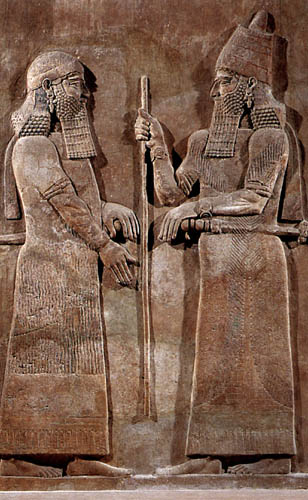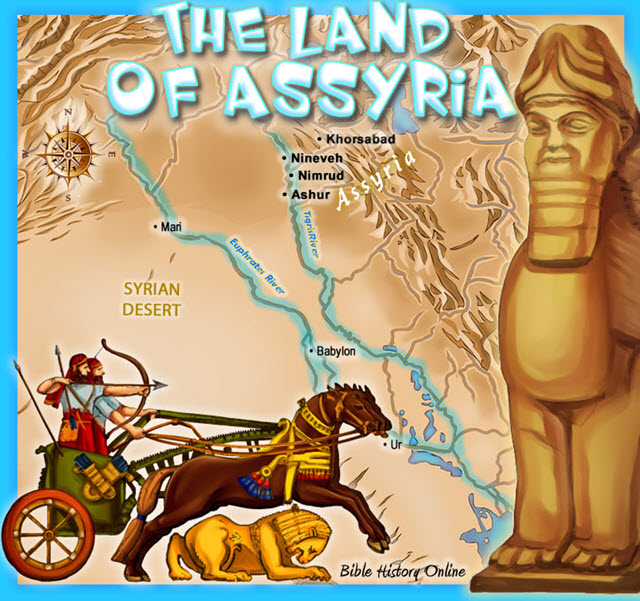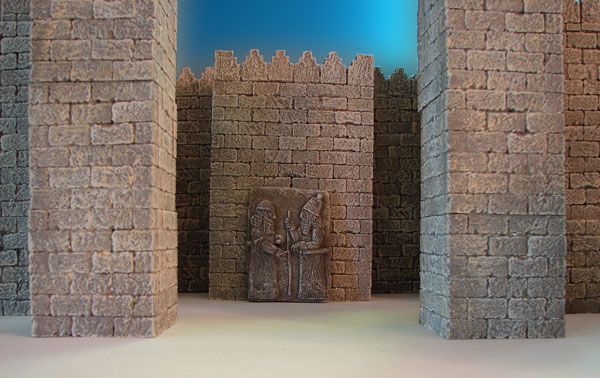|
|
|
 |
The Bible
Mentions Sargon and his Tartan. This
relief of
king Sargon greeting his Tartan (commanding officer) Sennacherib was discovered at
Sargon's palace
in Khorsabad. The Bible mentions
Sargon and his Tartan in Isaiah 20:1 |
This miniature replica is of Sargon II,
king of Assyria,
recognizing a high dignitary. The bas relief was discovered at the site of
Sargon's palace at ancient Khorsabad. The relief dates to the reign of Sargon II (721-705 BC). The original is
located at the Louvre Museum in Paris, France. It stands 3.3 meters tall.
Isaiah 20:1 -
In the year that Tartan came unto Ashdod, (when Sargon the
king of Assyria sent him,) and fought against Ashdod, and took it;

This map shows the primary capitals of the Neo-Assyrian Empire
Museum Images
 
Information About the Sargon II Bas
Relief
- Limestone bas-relief of Sargon II and his
Vizier
- The stone carved relief stands 3.3 meters high
- Currently at the Louvre Museum in France
- The relief was discovered by Paul Emil Botta in 1842
- Excavated at the site of ancient Khorsabad (Dur Sharrukin)
- Khorsabad was Sargon's capital city (Northern Iraq)
- The high dignitary is probably Sennacherib
- He might be receiving orders to conquer Jerusalem
- During the reign of King Sargon II (722-705 BC)
- Sargon is holding the staff of kingship, and wearing the royal cone
crown
- His left arm rests on his sword and sheath
- His hair is dressed in royal fashion, curled mustache and beard
- He has rings on his arms and ears representing his power over the
earth
- Notice the ball and ribbons holding his hair and cross earring
- He is wearing a finely embroidered fringed robe
- The Vizier is wearing jewelry and a fringed robe but less decorative
- The Vizier is wearing a rosette diadem (crown) of authority
- Sargon conquered Samaria, capital of northern Israel
- From the Neo-Assyrian Period (1000-612 BC)
- It was located at his Palace at Khorsabad (Dur Sharrukin)
5- "Then the king of Assyria came up throughout all the land,
and went up to Samaria, and besieged it three years.
6 - In the ninth year of Hoshea the king of Assyria took Samaria, and
carried Israel away into Assyria, and placed them in Halah and in Habor
[by] the river of Gozan, and in the cities of the Medes.
7 - For [so] it was, that the children of Israel had sinned against the
LORD their God, which had brought them up out of the land of Egypt, from
under the hand of Pharaoh king of Egypt, and had feared other gods,
8 - And walked in the statutes of the heathen, whom the LORD cast out
from before the children of Israel, and of the kings of Israel, which
they had made.
9 - And the children of Israel did secretly [those] things that [were]
not right against the LORD their God, and they built them high places in
all their cities, from the tower of the watchmen to the fenced city.
10 - And they set them up images and groves in every high hill, and
under every green tree:
11 - And there they burnt incense in all the high places, as [did] the
heathen whom the LORD carried away before them; and wrought wicked
things to provoke the LORD to anger: - 2 Kings 17:5-11
Interesting Note: An Assyrian scribe claimed that
one of the reasons for the death of Sennacherib was that a Lamassu fell
on him because of his impious deeds. Sennacherib was the Assyrian king
who lost his army attacking Jerusalem, destroyed by the "Angel of the
LORD."

Museum Excerpt
#
AO 19873-74
King Sargon II and a high dignitary
Khorsabad, northern Iraq
Neo-Assyrian, about 710-705 BC
Height: 3.3 meters
When he became king of Assyria, Sargon II decided to build a new capital
that will testify to the greatness of his reign. The whole city is
dedicated to the exaltation of the sovereign, down the length of the
outer wall whose 16,283 cubits match the numerical value of his name.
Built on a terrace spanning the wall, associated with several temples
and ziggurat, the huge palace overlooking the city. It includes more
than two hundred rooms and its space division reflects the functional
organization, with division into two sectors, each centered around a
large courtyard. The official or babanu area, through which one enters
the palace, for the chancellery, administration and various workshops. A
second bitanu zone shall comprise the throne room where the king holds
hearing before the wide range of private apartments.
This is an exterior façade of the private
sector that this relief comes. Sargon appears there, recognizable by its
tall and tapered royal tiara adorned with ribbons that he wears. Before
him stands a high dignitary whose diadem ribbons suggests that it is the
crown prince Sennacherib. Traces of pigments suggests that the reliefs
must be painted at least partially. Their combination with frieze murals
concurred to an auspicious deployment intended to magnify the role of a
sovereign who poses as elected master of the gods and of the cosmos.
Louvre Page
Sargon II and a high official
Khorsabad, palace of Sargon II
Neo-Assyrian period, reign of Sargon II (721-705 BC)
Gypseous alabaster
At the end of the 8th century BC, Sargon II, king of
Assyria, built a vast palace of over ten hectares in his new capital,
Dur-Sharrukîn (now Khorsabad). Part of the rooms and courtyards were
covered with a rich sculpted decoration. On this slab which was placed
on a façade of the northern part of the palace (façade L), Sargon II,
recognizable by his truncated cone headdress, is shown welcoming a high
official who could be identified as Sennacherib, the crown prince."
 The Assyrian
Empire The Assyrian
Empire
The first great military empire in ancient history
was the Assyrian Empire. By the time of Ashurnasirpal and Shalmaneser
III in the 9th century BC the Assyrians organized a mighty army of
nearly 200,000 soldiers. Their military strategy was unsurpassed up to
that time, and with the age of iron they were an unstoppable fighting
machine. They brought spearmen, archers, shieldmen, slingers, siege
engines, chariots, and a huge calvary into the battlefield. The mighty
Assyrians dominated the ancient world until they were crippled by the
God of Israel in the reign of Sennacherib. God raised up the Assyrians
to remove Israel out of his sight for their rebellion and idolatry, but
the Assyrians would also be punished also for their wicked ways. They
finally fell to the Medes and Babylonians in 612 BC and passed into
history.
 Assyrian Kings Mentioned in the Bible
Assyrian Kings Mentioned in the Bible
2 Kings 15:29 -
In the days of Pekah king of Israel, Tiglath
Pileser king
of Assyria came and took Ijon, Abel Beth Maacah, Janoah, Kedesh, Hazor,
Gilead, and Galilee, all the land of Naphtali; and he carried them
captive to Assyria.
2 Kings 15:19 - Pul the
king of Assyria came against the land, and Menahem gave Pul one thousand
talents of silver, that his hand might be with him to confirm the
kingdom in his hand.
2 Kings 18:9 -
And it came to pass in the fourth year of king Hezekiah, which [was] the
seventh year of Hoshea son of Elah king of Israel, that Shalmaneser king
of Assyria came up against Samaria, and besieged it.
Isaiah 20:1 -
In the year that Tartan came unto Ashdod, when Sargon the
king of Assyria sent him,) and fought against Ashdod, and took it;
2 Kings 19:16 -
LORD, bow down thine ear, and hear: open, LORD, thine eyes, and see: and
hear the words of Sennacherib,
which hath sent him to reproach the living God.
2 Kings 19:37 -
And it came to pass, as he was worshipping in the house of Nisroch his
god, that Adrammelech and Sharezer his sons smote him with the sword:
and they escaped into the land of Armenia. And Esarhaddon his
son reigned in his stead.
Ezra 4:10 - and the rest
of the nations whom the great and noble Asnapper brought
over, and set in the city of Samaria, and in the rest of the country
beyond the River, and so forth, wrote.
Assyrian Kings Names in Cuneiform
Archaeology
of Ancient Assyria
Timeline of Ancient Assyrian Kings
(During the Period of the Biblical Kings)
Assur-nasirpal II (885-860
B.C.) A cruel warrior king, he made Assyria into the most fierce
fighting machine of ancient world.
Shalmaneser III (860-825
B.C.) His reign was marked by almost constant war. He was the first
Assyrian king to come into conflict with Israel. King Ahab fought
against him, and king Jehu paid him tribute in 841 BC. His royal
inscriptions were more detailed and more numerous than any other king.
His building works were massive just like his father Assurnasirpal II.
See Shalmaneser
and the Black Obelisk.
Shamsi-Adad V (825-808
B.C.) Most of his reign was focused on Babylonia and his own internal
conflicts.
Adad-nirari III (808-783
B.C.) The little information about his reign mentions his building
projects at Calah and Nineveh, as well as a conflict at Der in Babylonia
and collecting tribute in Damascus, Syria.
Shalmaneser IV (783-771
B.C.) The limited knowledge of his reign reveal some conflicts in
Damascus and a period of decline in Assyria.
Assur-dayan III (771-753
B.C.) The little information about this ruler reveals Assyria being in a
period of decline.
Assur-nirari V (753-747
B.C.) There is very little information about his reign. The king of
Urartu boasted of a victory over this king of Assyria in an inscription.
Tiglath-pileser III (Pul)
(747-727 B.C.) He restored Assyria to a major world power. He is the "Pul"
mentioned in the Bible and the one who began to destroy Samaria, the
capital of the Northern Kingdom of Israel. He carried many away into
captivity. This captivity is mentioned in his own inscriptions, the
Babylonian Chronicle, and the Bible.
Shalmaneser V (727-722
B.C.) He besieged Samaria, the capital of the Northern Kingdom of
Israel. He died during the siege after imposing taxation on the holy
city (Asshur), and his son Sargon came to power.
Sargon II (722-705
B.C.) He completed the destruction of Samaria and the captivity of
Israel. He was also famous for his magnificent palace with his colossal
winged guardians.
Sennacherib (705-681
B.C.) He was the most famous of the Assyrian kings. He mentions the name
of Hezekiah on his prism during his war campaigns, he claimed to have
"Hezekiah captured in his own royal city (Jerusalem) like a caged bird."
His army was defeated at the gates of Jerusalem by the Angel of the
Lord. Sennacherib returned back to Nineveh and was killed violently by
his own son, as mentioned in the Babylonian Chronicle, The Bible, and
various other inscriptions. He also conquered Babylon.
Esar-haddon (681-668
B.C.) He rebuilt Babylon, invaded and conquered Egypt by crossing over
the Sinai Desert with Arab camels carrying water for his army, and was
one of Assyria's greatest kings. He died fighting Egypt.
Assur-banipal (668-626
B.C.) He destroyed the Thebes in Egypt and collected a great library,
innumerable clay tablets were found.
Assur-etil-ilani (626-607
B.C.) It was under his reign that the Assyrian Empire fell.
 Assyrian
annals mention contacts with some ten Hebrew kings: Omri, Ahab, Jehu,
Menahem, Hoshea, Pekah, Uzziah, Ahaz, Hezekiah, and Manasseh. Assyrian
annals mention contacts with some ten Hebrew kings: Omri, Ahab, Jehu,
Menahem, Hoshea, Pekah, Uzziah, Ahaz, Hezekiah, and Manasseh.
In the reign of Hoshea, king of Israel, Shalmaneser, king of
Assyria, twice invaded (2 Kings 17:3,5) the kingdom that remained, and
his successor Sargon II took Samaria in 722 BC, carrying away 27,290 of
the population as he tells in his Khorsabad Annals. Later Assyrian
kings, particularly Esarhaddon (681 BC - 668 BC), completed the task.
For More Info See:
Bible History Online
Map of the Land of Assyria

Kids Bible Maps
Primary Sources for Assyrian History
The Assyrian Annals. The scribes of the chief cities of the
Assyrians wrote the accounts of the king's military campaigns on
cuneiform tablets, and clay prisms or cylinders. The accounts are very
reliable, even though the accounts do not speak negatively of the
Assyrians and are meant to glorify the king. The annals also give much
detail to geography and Chronology. It is interesting how accurate the
Assyrians were with dates, they made use of an Assyrian Kings List or
the Eponym Canon.
The Assyrian Chronicles and Eponym Canon. The Assyrian scribes
organized their national events whether military, political or religious
every regnal year. The Babylonian Chronicles were structured the same
way. Assyrian records were kept very carefully, they took their dating
and their history seriously. They attached their record of events with
the solar year and with the name of an official who was known as the "limmu."
Their was a new limmu appointed every year. They recorded military,
political and religious events in every year and made references to
eclipses. The Assyrian records are highly dependable and allow Biblical
scholars a very accurate way of dating events and designating "eponyms"
for 244 year in Hebrew history, from 892-648 BC.
The Assyrian King List.
The Assyrian King List reveals a list of the kings of ancient
Assyria in chronological order, from the 2nd millennium BC to 609 BC. It
lists the name of the king, his father's name, the length of his reign,
and some great achievements.
Assyrian Sculptures. The limestone bas-reliefs discovered
from the palace walls of major Assyrian capital cities like Nineveh (Kuyunjik),
Nimrud (Calah), Khorsabad (Dur-Sharrukin), and the bronze bands on the
Balawat Gates reveal a wealth of history. The illustrative events were
carved be professional Assyrian artists like a modern day photographer
on the scene. The carvings reveal the military might and tactics of the
Assyrians, as well as the futility of those nations that defied their
might. These sculptures are on display in museums around the world, for
example: The British Museum in London, The Louvre in France, The Iraqi
Museum, and The Oriental Institute in Chicago.
The Bible. The Old Testament records the history of the Kingdoms
of Israel and Judah, along with the battles of other nations. It
includes the fall of the 10 tribes in northern kingdom of Israel in 722
BC by the Assyrians, as well as the
fall of the southern kingdom of Judah in 586 BC by Nebuchadnezzar of
Babylon. The Bible also records miraculous events surrounding people
like Elijah, and Jonah, as well as the slaying of 185,000 Assyrians at
Jerusalem by the Angel of the LORD. The events recorded in 2 Kings
generally agree with Assyrian and Babylonian sources. |






